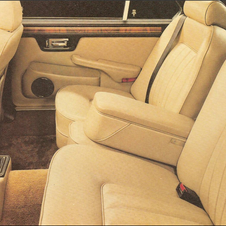The Vanden Plas Owners Club was established in 1980 and aims to help and encourage members to maintain these fine cars in good running order and appearance.
Daimler Double-Six & 4.2 Vanden Plas S3
The Series 3 models were produced from February 1979. The main difference from the earlier model was the Pininfarina restyled higher roof line which provided more headroom and a larger glass area.
The front door quarterlights were eliminated as was the vinyl covering to the roof and the rear light clusters were altered. The advanced Lucas-Bosch 'L-Jetronic' electronic fuel injection system was standardised on the 4.2 litre six-cylinder model giving an increased maximum power of 30bhp (DIN). The Daimler 4.2 Vanden Plas was equipped firstly with Borg-Warner model 65 automatic transmission and from summer 1979 the model 66 box. The Daimler Double-Six Vanden Plas was fitted with GM400 automatic transmission. With the inclusion of several mechanical refinements and better insulation the new Series 3 cars were very quiet and with their special trim and unique paint colours, the Vanden Plas Daimlers provided exclusivity at the top of the British Leyland model range.
Both models had servo assisted disc brakes all round with ventilated discs at the front. The 4.2 litre had stainless steel sculptured wheel trims with smooth hubcaps and the Double-Six spoked alloy wheels as standard. New wrap-around chrome and rubber bumpers were fitted and the external door handles were now flush fitting.
Many of the features offered as 'extras' on other models in the Jaguar/Daimler range were included as standard equipment in the Vanden Plas models. These included fully automatic air-conditioning, tinted glass, chromium waist mouldings and coachline, stereo radio/cassette player with 4 speakers, electric aerial, leather exclusive Vanden Plas style upholstery, front and rear seat headrests, inertia reel rear seatbelts, luxurious nylon rugs to all passenger footwells, Asian burr walnut veneered facia and door fillets, twin front foglights, quartz halogen headlamps, electric remote control for both door mirrors, adjustable reading lights, headlamp wash/wipe and front seat electric adjustment. Extra cost items on the 4.2 were an electric sunroof, spoked alloy wheels, trip computer on the redesigned central console and 'Power-Lok' limited slip differential, all of which were standard equipment on the Double-Six.
In 1981 the Double-Six Vanden Plas received the new Michael May designed 'fireball' high compression HE (High Efficiency) cylinder heads which brought much needed lower fuel consumption.
Few of the Series 3 cars were produced at Kingsbury before that factory closed in July 1979 and production transferred to Coventry. The Vanden Plas models ceased production in Autumn 1983 after 1159 Double-Six and 698 4.2 litre had been made.




